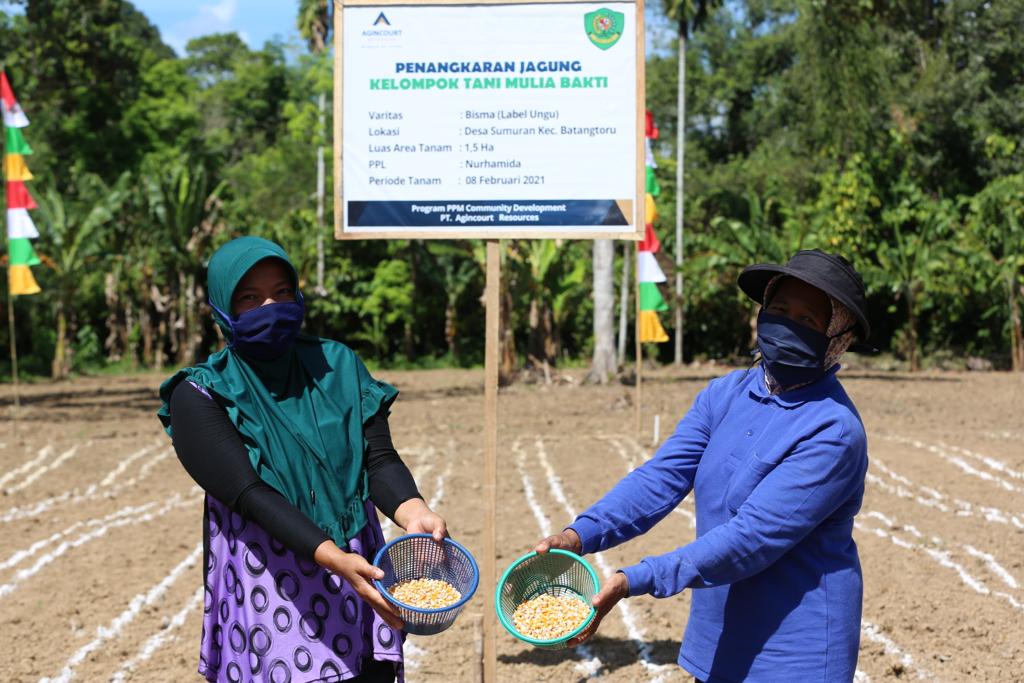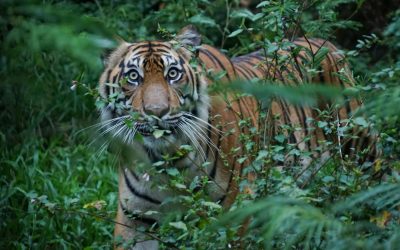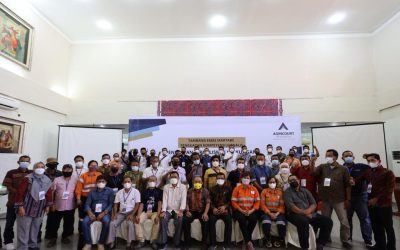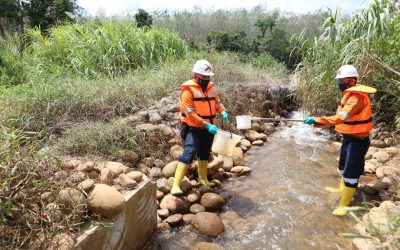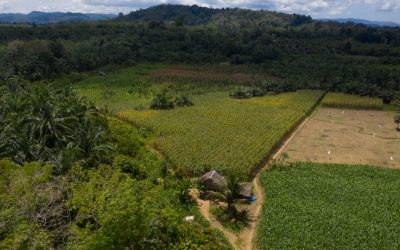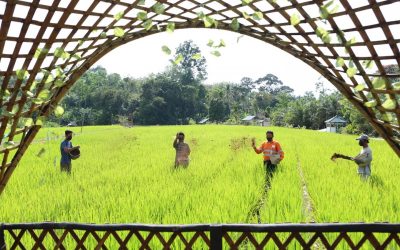About 200 km on the south side of Lake Toba, North Sumatra, lies the Batangtoru Forest, also known as “Harangan Tapanuli”, a tropical forest ecosystem that spans an area of 150 thousand hectares from lowlands, hills to mountains. The Batangtoru forest is one of the most important forests in Sumatra. Home to 20 protected species of mammals and 51 species of birds. There are 688 plant species in this forest, 8 of which are threatened with extinction and 3 species are endemic to Sumatra.
The high biodiversity in Batangtoru plays an important role in sustaining human life. Rainfall is very high in the Batangtoru ecosystem which has varying elevations; the lowest point is 133 masl with most of the forest above 850 masl and the highest point is 1,909 masl. Batangtoru holds enormous wealth and biodiversity.
There are about 10 sub-watersheds that get their water from the Batangtoru Forest. This forest, water and river ecosystem has important functions as a buffer, for regulating water management, preventing floods, erosion and landslides. This forest water is needed by hundreds of thousands of people in three districts; South Tapanuli, North Tapanuli and Central Tapanuli, for household purposes, plantations, fish farming and wetland agriculture. There are also large projects that are also highly dependent on water supply from the Batangtoru River, such as the Sipansihaporas hydroelectric power plant, the Batangtoru hydropower plant, the Sarulla Block geothermal development project and the Martabe Gold Mine which highly requires water to manage the mine.
In this case, it has been seen that the Batangtoru Forest is an important key and the parent in the regional ecosystem. Hundreds of thousands of residents, thousands of hectares of rice fields, dozens of fish farms in three districts, namely South Tapanuli, North Tapanuli and Central Tapanuli, are very dependent and have an interest in preserving the Batangtoru forest. The decline in the quality of the Batangtoru ecosystem is a nightmare and must be prevented. Absolute and non-negotiable.
As a social responsibility, PT Agincourt Resources (PTAR), as the operator of the Martabe Gold Mine in Batangtoru is fully aware that nature conservation is part of the work, integrated and not a separate matter. PTAR even has a special department to manage the environment with the community. The biodiversity of the Batangtoru ecosystem is seen by PTAR as a legacy that must be preserved and passed on to the next generation.
Application of Technology for the Environment
Environmental responsibility from PTAR has become a standard procedure. Management of the environment around the mine is handled carefully, transparently, and involves stakeholders such as local governments, community representatives, Non-Governmental Organizations (NGOs) and independent experts. The seriousness of PTAR in managing treated water can be seen from the results of research by an integrated team formed by the Governor of North Sumatra in 2013. This integrated team consists of representatives from local governments, experts from universities, representatives of PTAR employees and community representatives from villages/kelurahan in around the mine.
Research conducted by the Center for the Environment and Population, Research Institute of the University of North Sumatra (USU) proves that the treated water from the Martabe Gold Mine managed by PTAR does not effect on the quality of aquatic biota in the Batangtoru River. Meanwhile, routine monitoring carried out by the PTAR Environment Department and the Martabe Gold Mine Integrated Water Quality Monitoring Team consistently shows that the treated water meets the quality standards set by the government. This is confirmed by the results of the research conducted by the Center for the Environment and Population, the Research Institute of USU and the results of the research was submitted by the Head of the Center for the Environment and Population, Research Institute of USU, who is also a Professor of the USU Department of Biology, Prof. Dr. Ing. Ternala Alexander Barus, in front of journalists during a virtual gathering for the month of Ramadan, Tuesday, 4 May 2021.
From the results of this research, we found that there was no decrease in the length and weight of fish since the first research was conducted in October 2012. We found a total of 32 species of fish. We also took samples from this research not only around the Batangtoru River, but also the waters around the mining operational areas such as in Aek Pahu Tombak, and Hutamosu. Apart from fish, we also still find another aquatic biota such as plankton and benthos which can be an indicator of good water conditions for aquatic life. All concentrations of heavy metals that we found in fish from all samples are still far below the dangerous standard set by the Ministry of Health,” Ternala explained.
Ternala further stated that PTAR has made efforts to manage and monitor the quality of the treated water that has exceeded the Government’s provisions. The formation of the Integrated Team and regular research on the quality of aquatic biota around the mine operations demonstrate PTAR’s high commitment to environmental management. “Based on my observations so far in the extractive industry, only PTAR is committed to environmental management, to involve the community through the Integrated Team, and periodically collaborating with independent institutions to monitor the quality of aquatic biota.”
It should be noted that gold processing at Martabe has used advanced technology. Unlike traditional gold mines that use mercury, the Martabe Gold Mine uses cyanide to separate the gold. In excess levels, mercury and cyanide solutions are equally harmful to the environment and humans, but cyanide decomposes more easily in nature than mercury. However, the use of cyanide requires more advanced technology and handling.
Citing the research results from Bogor Agricultural University (IPB) students; Nuril Hidayati, Titi Juhaeti and Fauzia Syarif, stated that cyanide is a compound that is often found and is familiar in various industrial wastes. Cyanide in nature often appears as free cyanide but usually reacts to form metal cyanide complexes. Cyanide is very stable below the surface or without light but can undergo photolysis or decompose rapidly in water surface or soil surface exposed to sunlight and releases free, harmless cyanide.
Several cases have shown that it is possible to use plants for cyanide remediation in aquatic environments and screen for plant species suitable for local conditions. Phytoremediation of cyanide contamination was studied using cyanogenic plants that synthesize cyanogenic glucosides, compounds that easily decompose to cyanide when plant tissues are injured. Since cyanide is a natural component of this plant, they have an increased capacity to degrade cyanide. Phytoremediation researches using Urtica dioica (nettle) and Sinapis arvensis (a type of wild mustard) in a contaminated basin by harvesting the tops after two vegetative periods remove contaminants (research by Gerth, 2000).
Phytoremediation itself is an environmental detoxification process using green plants that can remove, absorb, or change various contaminants that are harmful to the environment. Environmental safety quality standards are also applied to the production of wastewater.
Before releasing treated water into the river, PTAR applies very strict procedures. Large quantities of water that have not reached environmental safety quality standards are contained in a large dam, then gradually flow into the treatment facility when it rains. The water that has gone through the treatment process and has met the threshold standards tested in the laboratory is then released into the river in the presence of parties of interest. Water from nature is returned to nature at levels that meet the water quality standards of the Batangtoru River.
“All processing facilities belonging to PTAR are under strict tiered supervision from the Central Government, North Sumatra Provincial Government to South Tapanuli District Government,” said Wira Dharma Putra, Senior Manager Processing of PTAR. “The processing at our mine is carried out until it is completely neutral and safe.”
The company, which recruits 70% of its employees from local residents, has had a satisfactory track record since 2013 in terms of environmental management. This gold mine won the Utama (Silver) award for the category of Contract of Work holder in the field of Mining Safety Management from the Directorate General of Mineral and Coal, Ministry of Energy and Mineral Resources in 2013 and the following years in a row until 2017. After that, the Company received Blue Rating Award for PROPER from the Ministry of Environment and Forestry in 2014-2015 to 2016 for the Environmental Management category. PTAR also received the Best award at the Indonesia Sustainable Business Award of 2019 or the Award for Sustainable Business in Indonesia initiated by Global Initiatives and PwC Singapore and Indonesia in Jakarta on 21 February 2020. The Best Award for the Land Use & Biodiversity category was received for the success of PTAR which was assessed committed to the rehabilitation and restoration of forest ecosystems.
The company under the auspices of the PT Astra International Tbk Group has never been absent from winning awards in various fields since 2013. Some of them are Platinum rating in the 2019 Asia Sustainability Reporting Rating (ASRRAT) event, one Utama (Silver) Award for the Mineral Mining Environmental Management category (for Contract of Work Permit Holders), and two Pratama (Bronze) awards for the category of Mineral Mining Safety Management & Management of Standardization and Mining Services Business in 2020 organized by the Directorate General of Mineral and Coal, MEMR, an award from Indonesian Journalists Association (PWI) in 2019 and a Subroto Award in 2019 which was handed over directly by the Minister of Energy and Mineral Resources at that time, Ignasius Jonan.
At the end of 2020, PTAR was also awarded an award by the Directorate General of Natural Resources and Ecosystems of the Ministry of Environment for being actively involved in the care and release of Sri Nabila, a female Sumatran tiger released in Gunung Leuser National Park, Gayo Lues, Aceh, approximately 500 km away from the Martabe Gold Mine. “The support given by PTAR is proof of the company’s commitment to sustainable environmental management. Not only does the company always maintain the achievement of environmental management compliance in accordance with the legislation but also actively supports the central and local governments, especially in mining operational areas to manage the environment sustainably, one of which is support for the protection of flora and fauna,” said Sanny Tjan, Director External Relations of PTAR.
Not only support for “Sri Nabila”, PTAR together with the North Sumatra Natural Resources Conservation Center (BBKSDA), also actively supports the rescue of protected birds, namely red lories (Red Lory/Eos Bornea), large beaked birds (Rhinoceros) and eagles (Niseaetus Cirrhatus). The list of fauna saved by BBKSDA and PTAR is still growing because the teams from BBKSDA and PTAR are actively providing counselling and guidance to the community by involving community and religious leaders.
Doing More for the Environment
However, the various awards did not make PTAR complacent. PTAR wants to do more as an appreciation for the community and the environment around the mine. PTAR is very dependent on and concerned about environmental sustainability and has an interest in maintaining the biodiversity of the Batangtoru area.
Replanting mining areas that have been utilized is a standard procedure, but preserving nature outside the mining area is also the responsibility of PTAR together with the community.
Based on phytoremediation research, PTAR together with the community planted trees of the types that grow a lot in the Batangtoru area. PTAR sows thousands of tree seedlings of various types of local species and distributes the seeds free of charge to the community for planting.
The commemoration of Environment Day of 2021 was held at Agincourt Resources with the theme Biodiversity and The Balance of Ecosystem. In this commemoration, on 5 June 2021, Agincourt Resources planted 300 seedlings of trembesi, sengon, and waru trees at Sabar Dump involving representatives of management and employees, contractors, TNI, Polri, and local Brimob. The purpose of planting the type of tree that can grow quickly such as sengon and trembesi is to get a shade factor. Some plants do not grow well in open areas, so we plant pioneer trees that can fix nitrogen and make the soil fertile.
In his speech on the 2021 Environment Day, Ruli Tanio, Director of Engineering of PTAR said, “This theme has an important meaning because nature conservation activities concern the future of our children and grandchildren and the next generation. Because when we plant a tree, it is the same as we are planting prayer, planting hope, planting all of our work for the sustainability of life. This tree planting invites all of us to strengthen our spirit and actions to maintain biodiversity and ecosystem balance.”
PTAR’s success in replanting former mining land can be seen from the presence of many animal species in the new ecosystem that is formed from tree seedlings produced by PTAR’s environmental department. These animals are various types of birds such as the Red Cinenen (Orthotomus sericeus), jungle honeybird (Hypogramma hypogrammicum), kacer bird (Copsychus saularis), Kehicap Ranting (Hypothimis azurea), Rimbang Pongpong (Macronous ptilosus) to various types of frogs such as green frog (Hylarana erythraea), bangkong kolong frog (Duttaphrynus melanostictus), kongkang cricket frog (Hylarana nicobariensis), tree frog (Polypedates otilopus), striped tree frog or gedindang (Polypedates leucomystax) and also mammals such as pythons, forest goats, turtles of Manouriaemys and Amydacartilagenia types. Types of trees that are planted and can restore soil fertility so that they can provide new habitats for many of these species ranging from sengon, waru, red meranti to durian. There are also local endemic plants such as Styrax Paralleloneurum or toba frankincense which grows a lot in the Tapanuli area.
PTAR does not stop returning “debt” to nature by focusing only on flora, PTAR also cooperates with wild animal breeding centres, and the North Sumatra Natural Resources Conservation Center (BBKSDA) to preserve wild animals trapped or illegally kept by residents.
In this collaboration, PTAR has been involved several times in caring for and releasing protected endangered animals such as leopard cubs, long-tailed macaques, gibbons, Sumatran tigers, pangolins and slow lorises. These animals were found in residential areas adjacent to protected forests and some were kept in chains by the residents, but then the North Sumatra BBKSDA officers persuaded the people who tied the monkeys to hand them over to be cared for and released into the wild. All of these activities are supported by PTAR.
Staff from the North Sumatra BBKSDA together with PTAR also regularly provide counselling to local residents about the importance of protecting the environment and providing awareness not to catch and hunt endangered animals that are protected to maintain the balance of the ecosystem. Public awareness, in general, is very good, they also maintain local wisdom not to conflict with animals that accidentally enter their settlements. People choose to avoid or repel in a good way when these animals come to their village.
However, there have been cases in the forest when the North Sumatra BBKSDA team conducted patrols and found traps set by poachers. Because of this, they and PTAR do not stop providing information to the community by cooperating with traditional and religious leaders.
PTAR’s Senior Manager Corporate Communications, Katarina Siburian Hardono, emphasized that support for environmental management outside of PTAR’s work area is a long-term commitment to implementing sustainable environmental management practices in addition to the internal operating environment of the Martabe Gold Mine. One of the sustainable environmental management activities in the mining area is through the rehabilitation program.
In 2019, PTAR has submitted a revised mine closure document with a guaranteed value of US$28.3 million so that all mining operational areas have a mine closure plan. “Over the past year, a total of 35.5 hectares of the area have been stabilized with cover crops. A total of 2,886 seedlings had been planted during 2019 and the company has prepared 5,828 seedlings from 45 plant species in the nursery facilities,” said Katarina.
From this, it can be seen clearly that PTAR’s commitment is not only limited to within the mining area but also has a commitment to support the preservation of nature and ecosystems outside the mining area. PTAR actively collaborates with various parties to jointly manage and preserve the environment in the Batangtoru area because, in principle, the nature we live in today belongs to future generations and the responsibility to protect it is the obligation of all parties. ***

